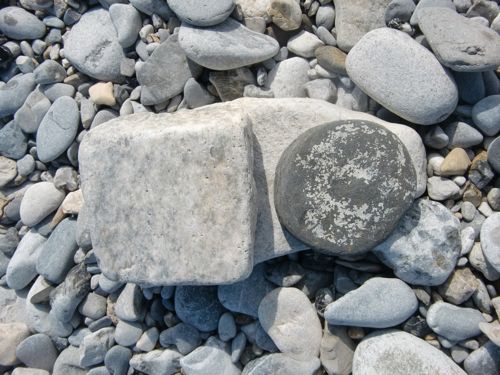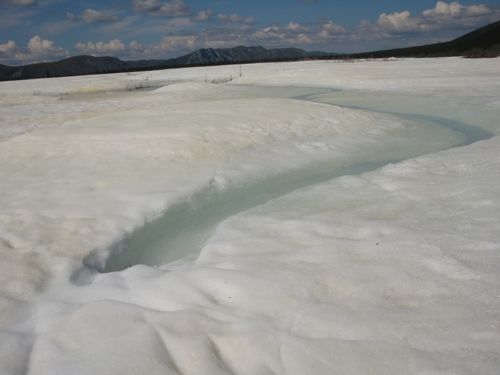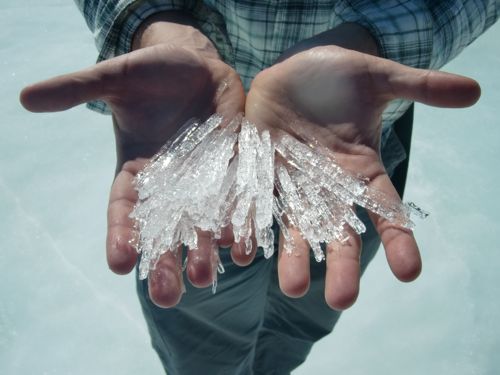It's a beautiful evening as I sit on here on the gravel at the edge of Mancha Creek. I'd include a picture for you, but it takes too many of those precious electrons to download pictures from my camera, sort and prepare them, and send them off through the ether. So you'll have to use your own imagination tonight. Don't worry--I'll add lots of images once we return to Fairbanks next week. (NOTE: somehow this journal didn't post while I was in the field, so I am re-posting it with all the bonus pictures I promised!)
 Here's the view from my creekside writing perch. The light is beautiful at 10pm as the sun makes its way along the horizon.
Here's the view from my creekside writing perch. The light is beautiful at 10pm as the sun makes its way along the horizon.
It's about 58F right now with a slight breeze. My little handheld Kestrel weather station puts it around 3mph. Almost enough to keep the mosquitoes away, but not quite. This gravel bar winds upstream and down for miles. Downstream takes you to its intersection with the Firth River, as well as to the border of Canada only a couple of miles away. We have been following the gravel bar upstream each of the past two days, sampling a couple of sites about 2.5 miles as the Raven flies (and 4 miles as the researcher walks), from camp. Our commute to work takes about 1 1/2 hours each way as we walk the gravel and wade the many channels of the creek. As we walk we intersperse shouting out 'Hey Bear' with looking at the beautiful rocks below our feet and the incredible scenery all around us. There's also plenty of time for idle conversation, bad jokes, a few songs, and quiet contemplation of our surroundings.
The gravels are quite varied. There's fossilized coral and ammonites (snail-like things) as well as all sorts of black and white-patterned rocks of varying sizes and shapes. Today I decided to specialize in shapes, and found a perfect circle rock as well as a square and equilateral triangle. Strange things happen as you wander along a gravel bar for hours on end!
 Rocking gravel bar geometry.
Rocking gravel bar geometry.
While we were on our way to our sampling site, we had to make a short stop at a large patch of Aufeis (pronounced 'off-ice').
 This Aufeis provides a cool respite from the day's hot temperatures.
This Aufeis provides a cool respite from the day's hot temperatures.
This Aufeis formed last winter as water from springs flowed across the top of the ice-covered river. It forms in a series of thin layers, and will last long into the summer. This ice was only perhaps a meter thick at the most, but formed a fairly solid sheet over a large portion of tundra. Its surface was laced with small streams.
 The meltwater has cut a small channel into the Aufeis.
The meltwater has cut a small channel into the Aufeis.
As the ice warms in the hot summer sun, it forms incredible ice needles that break apart as you lift a handful from the surface. This needle ice forms when soil temperatures are above freezing and the surface temperatures of the air are below freezing. In this case, the freezing air needed for this process was provided by the ice sheet. The subterranean liquid water is drawn to the surface through capillary action and then freezes into small needle-like columns.
 This is a handful of needle ice taken from the surface of the Aufeis sheet.
This is a handful of needle ice taken from the surface of the Aufeis sheet.
One of the things I've come up with during our walking is a new way to estimate temperature and wind speed. The Beaufort Scale is a good way to estimate wind speed by paying attention to moving leaves, bending trees, etc. Since there aren't that many trees around here to watch, I have had to come up with a substitute scale. I am calling it the Bugfort Scale. It uses the local biting insects as a way to make a rough estimate of both temperature and wind speed. Here's how it works:
Mosquitoes do best at temperatures between 50 and 75F, with an optimum mosquito temperature around 65-70F. They are not particularly strong fliers, so they fade out once the wind speed exceeds 5-10 mph.
Horseflies are like the 747s of the biting insect world. They seem to prefer temperatures between 70 and 80F and meet their optimum above 75F. They are strong fliers and do well in wind speeds between 5 and 15mph. Luckily, while they are strong fliers they are not fast fliers. The crunch sound they make when smushed is good for the soul (yours, not theirs). Once the wind really gets going, they disappear.
Deer flies seem to prefer the really hot temperatures. 75-80F suits them just fine. They aren't particularly strong fliers, so they leave the biting to the horseflies once the wind speeds pick up.
As we wander the hillsides coring trees, we manage to hit a variety of microclimates. It's pretty easy to tell the temperature and wind speed by paying attention to who's biting you! You can pass from the mosquito zone into deer fly town, and then seamlessly transition into horsefly heaven without even blinking an eye. I will continue to refine this Bugfort Scale during the next few days here and report back on any modifications I make. Until then, don't forget the DEET!!
 The Bugfort Scale would rate this as a perfect day for mosquitoes. 65F, no wind, and lots of moisture. Get out the bug hat!
The Bugfort Scale would rate this as a perfect day for mosquitoes. 65F, no wind, and lots of moisture. Get out the bug hat!
